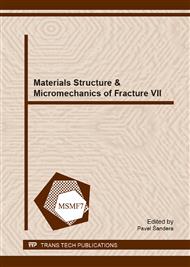p.643
p.647
p.651
p.655
p.660
p.664
p.668
p.672
p.676
Influence of Heat Treatment on Crack Tip Opening Displacement and on Resistance of Crack Propagation of Alloyed Steel
Abstract:
The aim of the performed investigations was to determine the influence of two different heat treatment procedures, i.e. hardening and tempering vs. austempering, on some mechanical properties, as well as the influence of these procedures on the magnitude of some fracture mechanics parameters for example, crack tip opening displacement (CTOD) and J-integral. The experimental investigations were performed on the specimens made of spring steel 65Si7 (chemical composition: 0.69% C, 1.56% Si and 0.90% Mn).
Info:
Periodical:
Pages:
660-663
Citation:
Online since:
November 2013
Authors:
Price:
Сopyright:
© 2014 Trans Tech Publications Ltd. All Rights Reserved
Share:
Citation:


